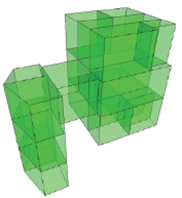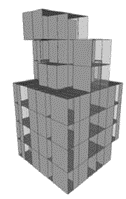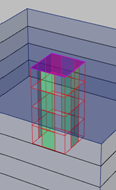
Lighting Performance for AI Building Structural and Thermal Optimisation and Design
In this MSc-thesis research project, for building spatial designs, it is investigated how the introduction of lighting performance objectives influences automated design and optimisation processes, so far including structural and thermal objectives only. Besides disciplinary aspects, as such also the generic upscaling from 2 to 3 objectives is investigated.
Introduction
The built environment sees a very challenging future. An enormous number of buildings must be renovated or newly built, with less energy consumption, cradle to cradle principles, and optimised domain specific aspects, including structural safety. With the idea that not only building designs should be optimised, but also the underlying design processes, at Eindhoven University of Technology an AI toolbox has been developed, available open source on GitHub. The toolbox allows for the automated design and optimisation of buildings, via among others representation transformations; zoning by pattern recognition; disciplinary grammars; the finite element method; RC-networks; clustering; genetic algorithms; topology optimisation, etc. A very recent development is the allowance for non-rectangular spatial designs, as shown in figure 1.



Figure 1, (a) non-rectangular spatial design, (b) design with façade openings, (c) lighting simulations with Honeybee.
Method
The project will start with a brief literature research on AI in building design, whereafter the toolbox is explored, including some primary C++ experiments. Then criteria for light optimization are identified, and a lighting simulation framework is selected, specifically suited for these criteria and the representations of the toolbox. Design simulations then follow with rectangular designs, and if possible, with non-rectangular designs as well. Parameter studies will show how the introduction of the lighting objective and related criteria will alter designs and processes (which is very relevant for further studies too). For instance, by testing academic designs, via only using the lighting objective, using this objective with structural or thermal objectives, or by a combination of all three. If there is still time, also genetic algorithms or even hybrid simulations could be studied, instead of design simulations, in a similar fashion. Finally, a thesis will be written in paper format, about 8000 words only, with appendices.
Requirements
We are looking for an enthusiastic and bright student, interested in design, optimisation, lighting, AI, and programming, preferably with good grades for Applied Mechanics (SED) or Physics (BPS) courses. A rewarding and state-of-the-art project is offered, which likely will result in a conference or journal paper. The project will be supervised by Dr. H. Hofmeyer (SED) and Dr. M. Aarts (BPS). If you would like to have more information on the project, do not hesitate to contact Dr. H. Hofmeyer, VRT 9.32, 040-247-2203, h.hofmeyer@tue.nl.